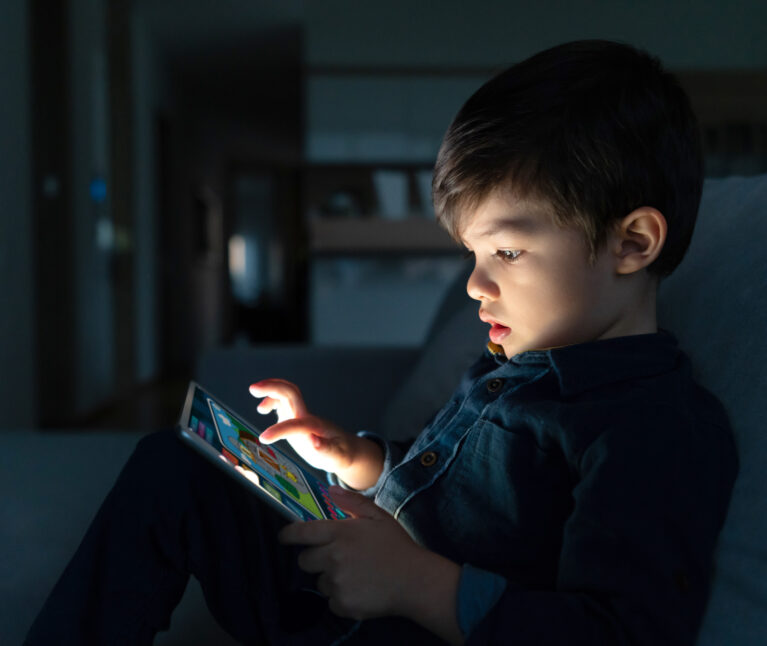Of all the childrearing issues parents face today, managing screen time is undoubtedly one of the most challenging and confusing. In fact, 71% of parents with a child under the age of 12 report that they are at least somewhat concerned about the amount of time their child spends on screens, according to a 2020 Pew Research Center study. Just how much time is that? The CDC reports that kids ages 8-18 spend an average of 7.5 hours every day in front of a screen for entertainment.
All this time spent on the Internet and smartphones has led to increasing concerns among parents. Despite these concerns, parents also realize that there are benefits to greater connectivity, too. Smartphones allow parents to have direct communication with their children anytime, anywhere, and GPS tracking can provide parents of tweens and teens peace of mind. Of course, tablets, smartphones and other devices also help kids stay entertained and learn new things.
So, what should parents who are navigating this complicated topic be looking out for as their child spends more time on screens?
Keeping an Eye on Your Child’s Mental Health
When we give our child a smartphone, we hope it will be used in all the right ways. But we’re also very much aware of the dangers kids can encounter online. During Mental Health Awareness Month, we’re focusing on the importance of making sure that your child’s phone and other screen time enhances, not detracts, from their mental well-being.
As much as parents, child health professionals, researchers and others wish they had a better idea of what kids are viewing online, there has never been a good way to do that. Children and adults alike jump from a website to an app to a game or elsewhere every few seconds. We’re all moving around the Internet at lightning speed, often viewing dozens, if not hundreds, of pages each day.
What if a tool could quickly analyze millions of pieces of data to record and study everything being visited online, and for how long? A tool that provides a clear view of what children are spending their screen time on, one that operates at the new speed of life.
While this may sound hard to imagine, it’s currently in development at Stanford.
Introducing Screenomics
Stanford researchers are now working on a field of research they’ve dubbed “Screenomics,” which provides a time-series analysis of screens and digital behavior. Everyone’s screenome, or map of all their app use, communication, and web visits, is unique, and provides a wealth of information.
Standford’s “Human Screenome Project” is a reference to the Human Genome Project, the international, collaborative research program that sequenced and mapped all the genes of human beings. Research participants in Stanford’s Screenomics program install a monitoring app on their smartphones, after they have given full consent for use of their data, that takes a snapshot of the screen every few seconds. The research program ensures their privacy.
The Stanford Screenomics Lab has worked with more than 600 participants and has collected over 400 million screenshots. One of its first findings was that people jump from screen to screen incredibly quickly—about every 10 to 20 seconds. It also found that media use varies widely and contains threads of experience that cut across radically different content. While a minute of one teen’s screenome might show them going from Amazon to Instagram to TikTok, another teen’s might show them going from YouTube to Instagram to Snapchat. We all have our own unique screenome, and it changes every minute or every hour of every day.
Stanford Screenomics researchers Byron Reeves, Thomas Robinson, and Nilam Ram authored an article in Nature that explains how the project works:
“The software records, encrypts, and transmits screenshots automatically and unobtrusively every five seconds, whenever a device is turned on. This approach differs from other attempts to track human–computer interactions—for instance, through the use of smartwatches and fitness trackers, or diaries. It is more accurate, it follows use across platforms, and it samples more frequently. In fact, we are working on software that makes recordings every second.”
The Human Screenome Project has the potential to enable mental health professionals and researchers to observe behavior in real time and recommend interventions for their young patients. A child’s smartphone screenome will reveal areas that most attract and distract that child. Problematic content and behavioral patterns can be detected and treated far more quickly and precisely than ever before, promoting mental wellness. They even predict all this will occur on the smartphone itself. The Screenomics Project is relatively new, and early in its development, but every day it becomes a more accurate, useful tool to help mental health professionals optimize mental wellness in children.
If you would like to make a gift to further advance the Stanford Human Screenome Project, please contact Laura Andersen at laura.andersen@lpfch.org.
